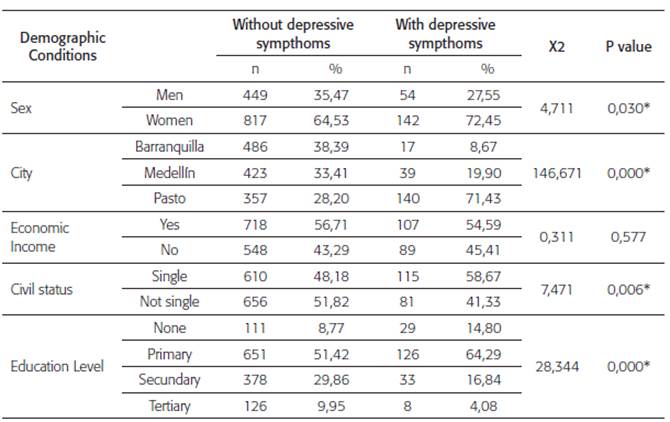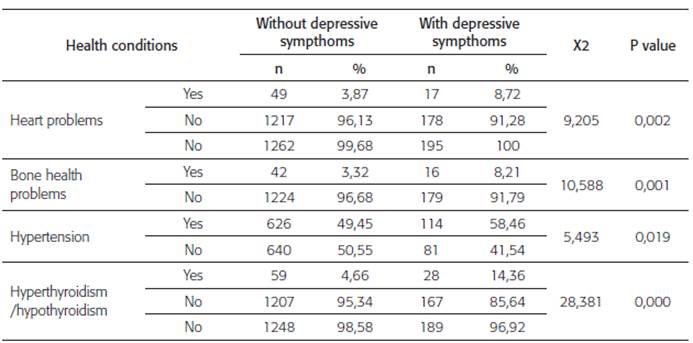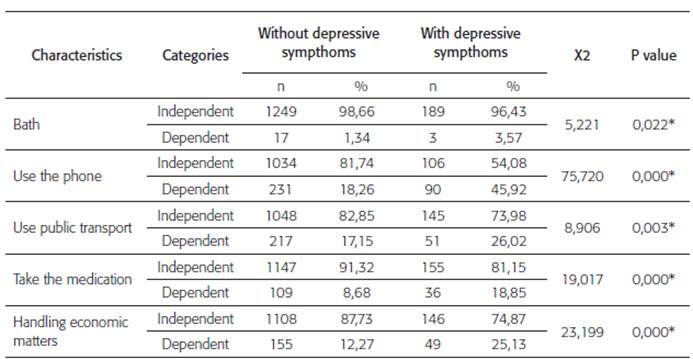INTRODUCTION
In Colombia, the population of 60 years or more has growth rates higher than that of the total population; In 2005, the number of elderly people was 3,815,453, and 4,473,447 in 2010, with an annual growth rate of 3.18 % in that period, projecting an increase of 3.76 % by 2020. 1.
In developing countries, the health challenges faced by this population include an increase in the prevalence of chronic noncommunicable diseases, as well as a functional and cognitive deterioration that is aggravated by the socioeconomic environment of the country 2.
Depression is the most frequent psychiatric disorder among older adults 3; According to the World Health Organization (WHO) unipolar depression affects 7 % of people over 60 years of age and represents 5.7 % of years lived with disabilities in this population 4. In Colombia, the last mental health study reported that in people over 45 years of age, the prevalence of any depressive disorder was 5 % 5. In a study carried out in the department of Antioquia, the estimated prevalence of risk of depression in the elderly was 26.3 %, with women representing 64.2 % of the population at risk 6.
In the elderly, depression occurs with episodes of crying, sadness and apathy, accompanied by hopelessness, negligence, suicidal ideation, guilt, changes in sleep pattern, alterations in appetite, bowel movements, libido, among others 5,7. This symptomatology affects different dimensions of the older adult, including the physical, functional and social state.
In older adults diagnosed with depression, a high comorbidity has been found with chronic noncommunicable diseases such as diabetes mellitus 8, neoplastic pathology 9, pulmonary disease 10, among others.
In addition, depression affects eating behavior leading to malnutrition in older people 11. In countries such as South Africa, where the prevalence of geriatric malnutrition is high, it has been identified that more than 70 % of those who have this condition also experience depressive symptoms 2.
On the other hand, adults with symptoms of depression have a higher functional deficit 12, even geriatric depression has been negatively correlated with muscle strength, body resistance and flexibility in the lower part of the body, as well as muscle strength of the arm, agility and dynamic balance 13, which would affect the adequate performance in the activities of daily life.
Starting from the above, depression is a disease that decreases the quality of life of the elderly 14 and those who suffer it are unable to take advantage of the resources that surround them, because they lose autonomy due to their mental state. From this point of view, it could be argued that older adults with depression are in a state of vulnerability, understanding this concept as the limitations that a person has to take advantage of the resources generated by the state, the market and / or the community 15.
In Colombia there are no studies comparing depression in the elderly according to the city of residence; An example of this is that in the last National Mental Health Survey, conducted in 2015, a comparison was made of the prevalence of depression according to the regions of Colombia, but an analysis segregated by cities was not carried out 5. The present study aims to explore the demographic, health, and functionality factors associated with depression in older adults in three cities of Colombia: Medellín, Barranquilla and Pasto, in order to provide information to improve the quality of life of this population.
MATERIALS AND METHODS
Type of study
An analytical cross-sectional study was conducted in 2016, from a primary source of information for the search of the factors associated with depression in older adults residents in three cities of Colombia, selected by the number of elderly people and classified as large, medium and small populations: Medellín (391,429), Barranquilla (145,947) and Pasto (42,271) in 2016, according to DANE projections.
Participants
The study population corresponded to a probabilistic sample of 1514 adults 60 year of age and older, living in the urban area of the cities of Medellín (495), Barranquilla (513) and Pasto (506). This study is part of a macro project funded by Colciencias, where the calculation of sample size was made using the formula for finite populations, with a confidence level of 95 %, a sampling error of 5 %, a proportion of good health condition of 50 % and a design effect of 1.0, the sample size being enlarged by 15 % to correct possible information losses. The selection of the sample was carried out by means of a probabilistic sampling, by conglomerate, two-stage, according to the geographical and administrative distribution of each city. The present study on depression took the database of the macro project.
Instruments
Asurvey was applied to selected older adults, which consisted of questions related to demographic characteristics (age, sex, marital status, educational level, place of residence, etc.), and physical health status (diabetes, heart problems, nutritional, bone health, hypertension, etc.). To evaluate the depression, the Yesavage Geriatric Abbreviated Depression Scale was used, which consists of 15 questions (10 positive and 5 negative) and explores cognitive symptoms of a major depressive episode during the last fifteen days. The scale is widely used given that its completion requires five minutes on average, in addition, it presents an internal consistency and construct reliability in the Colombian population of 0.78 and 0.87, respectively 16.
For the measurement of functional capacity Barthel's instrument was used to evaluate independence in basic activities of daily life such as eating, bathing, dressing and undressing, going up and down stairs and moving around. The instrument shows good interobserver reliability with Kappa indexes between 0.47 and 1.00, and a Cronbach's alpha of 0.86 17. Finally, the Lawton and Brody Scale was used to evaluate some instrumental activities of daily life such as using the telephone, using public transportation, taking medication, and managing economic matters; This instrument has an inter and intra-observer coefficient of 0.94 18.
Process
A pilot test was conducted on 20 people over 60 years old living in the urban area of the city of Medellín, with a duration of 8 days, in order to calibrate the instruments to be applied, standardize the pollsters, verify that the questions were correctly elaborated and categorized, and also select the most appropriate techniques for quality control of the information collected. The present study was approved by the Institutional Ethics Committee of the CES University and written informed consent was requested from older adults, following application of the instruments, in accordance with Resolution 8430 of 1993 of the Ministry of Health of Colombia that regulates research on human subjects.
Analysis of data
The Chi-square test was used to evaluate the association between depression and demographic, health, and functional conditions in older adults, assigning a level of significance of 0.05 to reject the null hypothesis. Additionally, with the variables that met the Hosmer Lemeshow criterion of a p-value less than 0.25 in the association test, crude prevalence ratios (PR) were calculated and were taken to an adjusted multivariate model to estimate adjusted prevalence ratios, with 95 % confidence intervals, to determine the strength of the association. The statistical analyzes were carried out through the SPSS program, version 21 (CES University License).
Results
It was found that 83.6 % (1266) of the older adults evaluated did not report having depression, while 12.9 % (196) had symptoms of depression, while in 3.4 % (52) of the sample there was no response to the scale applied. By sex, a statistically significant difference was found between men and women, with a higher proportion of women with symptoms of depression.
When discriminating by city, in the group without depression the highest percentage corresponded to the city of Barranquilla, in contrast to the city of Pasto where the largest sample with depression was located, finding a statistically significant association between the city where the elderly person resides and the presence of depression.
It was found that the economic income in the last month was not associated with depression in the elderly, with the civil status and educational level was found association with the presence of depression. Older adults with depression were the most likely to report that they were unmarried and with a primary level of education (see table 1).
Table 1 Presence of depression according to the demographic conditions of the older adult of Barranquilla, Medellín and Pasto

*p value <0,05 statistically significant. Researchers' calculations
According to health conditions, older adults with depression reported more problems with heart, bone health, hypertension, and hyperthyroidism / hypothyroidism than their peers without depression. While diabetes, nutritional problems, lung disease and the presence of tumors were conditions that were not associated with the presence or absence of depressive symptoms (See table 2).
Table 2 Presence of depression according to health conditions in the elderly of Barranquilla, Medellín and Pasto

*p value <0,05 statistically significant. Researchers' calculations
In the functional conditions, it can be seen that of the basic activities of daily life, independence in the bathroom was the only one that was associated with depression, finding a greater proportion of older adults with depression dependent on this activity, in contrast to the group without depression; however, instrumental activities of daily life such as using the telephone, using public transportation, taking medication and managing economic issues were associated with depression, with a higher proportion of older adults with depression dependent on these activities (see table 3).
Table 3 Presence of depression according to the conditions of functionality in the older adult of Barranquilla, Medellín and Pasto

*p value <0,05 statistically significant. Researchers' calculations
Additionally, the prevalence ratio (PR) was calculated as a measure of strength of association, observing that living in the city of Pasto increased the occurrence of depression symptoms up to 4.25 times, while it was confirmed that living in the city of Barranquilla reduced it by 63 %. On the other hand, having no educational level increased more than other demographic variables the association to develop depression in the older adult (PR = 4.11), even in the model adjusted for demographic covariates, morbidity, and functionality, was the variable that most increased the prevalence of depression. Hyperthyroidism / hypothyroidism was the health condition that increased the association (RP = 3.43), while in the instrumental activities it was the dependence to use the telephone (RP = 3.80) (see table 4). Some morbidity variables such as problems in bone health and tumors; and some of functionality such as bathing, going up and down stairs, using public transportation, taking medications and handling economic issues, lost their significance when the association was adjusted for confounding variables.
DISCUSSION
In the three cities of Colombia where the study was conducted, it was found that demographic factors such as sex, city of residence, marital status and educational level were associated with depression in the elderly.
These results confirm the findings of studies in mental health in the country, in which it has been reported that women show more symptoms of depression than men 5-6; This can be explained by genetic, neuroendocrine, and personality factors, as well as by patterns of socialization and social culture, including the differences between sexes in living conditions and in the distribution of opportunities 19. The results of the present investigation are also in agreement with other studies carried out in older Colombian adults where it has been identified as risk factors for depression being a woman, being widowed or single and having a low educational level 20-21.
Likewise, the National Mental Health Study in Colombia found that the prevalence of depression was higher in the Pacific region, where the city of Pasto is located, in comparison with the central and Atlantic regions, where the cities of Medellín and Barranquilla are located, respectively 5. However, depressive symptoms in elderly residents of the city of Pasto have been explained by the demographic conditions, income level and health status of this population 22, which is related to high poverty rates and social inequality found in the pacific region 23.
On the other hand, health conditions were also associated with depression in the elderly, especially hypertension, hyperthyroidism / hypothyroidism, heart problems, and bone problems. According to Giner et al. 24, the comorbidity between depression and physical illnesses is very frequent and has an important impact on the deterioration of health, even depression can mediate the pharmacological treatment of these diseases.
On a functional level, depression was associated with dependence to bathe, use the telephone, use public transportation, take medication and handle economic issues. In this regard, Kronfly et al. 25 carried out a study with people over 75 years of age and found that depression affected the basic activities of daily life, but not the instrumental activities, therefore, the differences between the studies what is evidence is the influence of the social context on the perception that the older adult has of his state of functionality.
A possible limitation of this study is the introduction of some biases in the measurement of depression as a measure of self-report and not necessarily an established medical diagnosis, which may overestimate its prevalence. However, the use of the Yesavage scale has been widely used and its consistency allows us to consider that the observed values are adjusted to reality. Although the design of the study does not allow the establishment of associations of a causal type because it is not their intention, the associated factors may suggest some conditions that should be considered in preventive interventions with the elderly population. This study excluded rural population, hospitalized and residents in geriatric homes where conditions may be more precarious and may contribute to a greater perception of depressive signs and other factors associated with these conditions in particular so that the findings of this study may limit extrapolation to older adults in these particular conditions.
This study provides relevant information on the mental health of the elderly in Colombia, taking into account that it is a vulnerable population to present mental disorders, due to the physical changes generated by age and social conditions that do not favor adaptation to these changes. This study confirms that depression is a phenomenon associated with multiple modifiable factors that can be intervened in a timely manner, from public health for example and therefore, its understanding is not limited to the findings reported, although these become a precedent for future research on aging in the country.
CONCLUSION
The high prevalence of depression in the elderly, is associated with demographic and health conditions, and globally affects the functionality of the elderly. Faced with this situation, public health actions are needed that promote the prevention of depression in the elderly, including through the establishment of support networks for this population, especially in the city of Pasto where the largest occurrence of the disease was obtained.
The information generated by this research can be useful for public policies that are aimed at active, satisfactory and healthy aging in Colombia and therefore it is necessary to address it from public health that promotes the prevention of this condition if you want to contribute to the goals of active, satisfactory and healthy aging in Colombia and a better quality of life for this population.















